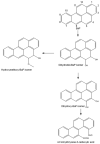Benzo[A]Pyrene Biodegradation by Multiple and Individual Mesophilic Bacteria under Axenic Conditions and in Soil Samples
- PMID: 36767220
- PMCID: PMC9914810
- DOI: 10.3390/ijerph20031855
Benzo[A]Pyrene Biodegradation by Multiple and Individual Mesophilic Bacteria under Axenic Conditions and in Soil Samples
Abstract
To date, only a handful of bacterial strains that can independently degrade and utilize benzo[a]pyrene (BaP) as the sole carbon source has been isolated and characterized. Here, three new bacterial strains-JBZ1A, JBZ2B, and JBZ5E-were isolated from contaminated soil and, using 16S rRNA sequencing, were identified as Brad rhizobium japonicum, Micrococcus luteus, and Bacillus cereus, respectively. The growth ability of each individual strain and a consortium of all strains in the presence of BaP (4-400 µmol·L-1, pH 7, 37 °C) was identified by the doubling time (dt). The results illustrate that dt decreased with increasing BaP concentrations for individual strains and the consortium. The optimum growth conditions of the consortium were 37 °C, 0.5% NaCl (w/v), and pH 7. Under these conditions, the degradation rate was 1.06 µmol·L-1·day-1, whereas that of individual strains ranged from 0.9 to 0.38 µmol·L-1·day-1. B. cereus had the strongest contribution to the consortium's activity, with a degradation rate of 0.9 µmol·L-1·day-1. The consortium could also remove BaP spiked with soil but at a lower rate (0.01 µmol L-1.day-1). High-performance liquid chromatography-high-resolution tandem mass spectrometry permitted the detection of the metabolites of these strains, and a biodegradation pathway is proposed.
Keywords: bacterial consortia; bioremediation; chromatography; mass spectrometry; polyaromatic hydrocarbons.
Conflict of interest statement
The authors declare no conflict of interest.
Figures





References
-
- Lawal A.T. Polycyclic Aromatic Hydrocarbons. A Review. Cogent Environ. Sci. 2017;3:1339841. doi: 10.1080/23311843.2017.1339841. - DOI
-
- Ramesh A., Harris K.J., Archibong A.E. Chapter 40—Reproductive Toxicity of Polycyclic Aromatic Hydrocarbons. In: Gupta R.C., editor. Reproductive and Developmental Toxicology. 2nd ed. Academic Press; Cambridge, MA, USA: 2017. pp. 745–763.
-
- Gray J.P. Benzo(a)Pyrene. In: Wexler P., editor. Encyclopedia of Toxicology. 3rd ed. Academic Press; Cambridge, MA, USA: 2014. pp. 423–428.
Publication types
MeSH terms
Substances
LinkOut - more resources
Full Text Sources
Molecular Biology Databases

